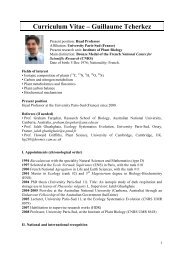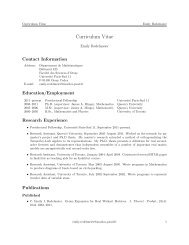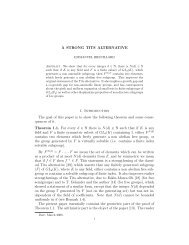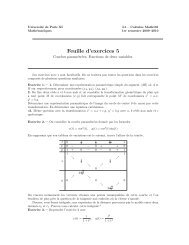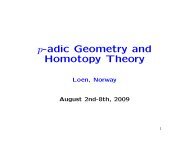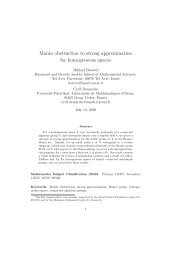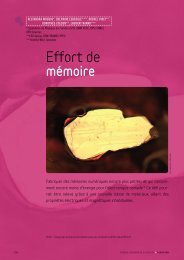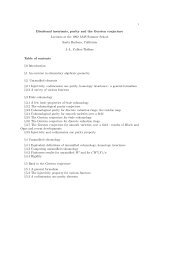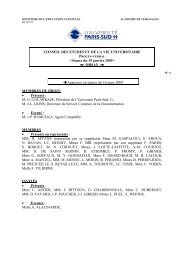The optical properties of artificial media structured at a ...
The optical properties of artificial media structured at a ...
The optical properties of artificial media structured at a ...
You also want an ePaper? Increase the reach of your titles
YUMPU automatically turns print PDFs into web optimized ePapers that Google loves.
<strong>The</strong> <strong>optical</strong> <strong>properties</strong> <strong>of</strong> <strong>artificial</strong> <strong>media</strong> <strong>structured</strong> <strong>at</strong><br />
a subwavelength scale<br />
Philippe Lalanne 1 , Mike Hutley 2<br />
Abstract ⎯ In most <strong>optical</strong> m<strong>at</strong>erials the <strong>at</strong>omic or molecular<br />
structure is so fine th<strong>at</strong> the propag<strong>at</strong>ion <strong>of</strong> light within them may<br />
be characterized by their refractive indices. When an object has<br />
structure which is larger than the wavelength <strong>of</strong> light, its<br />
influence on the propag<strong>at</strong>ion <strong>of</strong> light may be described by the<br />
laws <strong>of</strong> diffraction, refraction and reflection. Between these two<br />
extremes is a region in which there is structure th<strong>at</strong> is too fine to<br />
give rise to diffraction but is too coarse for the medium to be<br />
considered as homogenous. For this, a full description can only<br />
be achieved through a rigorous solution <strong>of</strong> Maxwell's<br />
electromagnetic equ<strong>at</strong>ions and resonance phenomena are <strong>of</strong>ten<br />
observed. Recent developments in micro-lithography have<br />
extended the possibility <strong>of</strong> gener<strong>at</strong>ing sub-wavelength structures<br />
and it is now possible to produce m<strong>at</strong>erials with remarkable new<br />
<strong>optical</strong> <strong>properties</strong>.<br />
Index Terms ⎯ Artificial dielectrics, subwavelength structures,<br />
photonic crystals, effective medium theory.<br />
I. INTRODUCTION<br />
<strong>The</strong> basic principles <strong>of</strong> <strong>optical</strong> design and<br />
the physics <strong>of</strong> reflection, refraction and diffraction<br />
on which it is based, have been well understood for<br />
a very long time. This knowledge has enabled the<br />
successful development <strong>of</strong> <strong>optical</strong> science and<br />
technology over the last couple <strong>of</strong> centuries and in<br />
recent years has been developed to new levels <strong>of</strong><br />
sophistic<strong>at</strong>ion with the availability <strong>of</strong> computer<br />
programs for the optimiz<strong>at</strong>ion <strong>of</strong> all types <strong>of</strong> system.<br />
However, until rel<strong>at</strong>ively recently the whole <strong>of</strong><br />
<strong>optical</strong> technology has been limited by the very<br />
reasonable constraint th<strong>at</strong> <strong>optical</strong> systems can only<br />
be designed to be made from m<strong>at</strong>erials th<strong>at</strong> are<br />
actually available! Consider the very simple task <strong>of</strong><br />
designing an antireflection co<strong>at</strong>ing to work <strong>at</strong> one<br />
wavelength <strong>at</strong> normal incidence. <strong>The</strong> theory tells us<br />
th<strong>at</strong> a single layer will gener<strong>at</strong>e two reflected waves,<br />
one from the air/layer interface and one from the<br />
layer/substr<strong>at</strong>e interface. If the <strong>optical</strong> thickness <strong>of</strong><br />
the layer is such th<strong>at</strong> the two are exactly out <strong>of</strong> phase<br />
and th<strong>at</strong> the refractive index <strong>of</strong> the layer is equal to<br />
the square root <strong>of</strong> th<strong>at</strong> <strong>of</strong> the substr<strong>at</strong>e, the two<br />
reflections will have the same amplitude and will<br />
cancel exactly. So a single layer will behave as a<br />
perfect antireflection co<strong>at</strong>ing. Unfortun<strong>at</strong>ely most<br />
common <strong>optical</strong> glasses have a refractive index in<br />
the region <strong>of</strong> 1.55, so the layer needs to have a<br />
refractive index <strong>of</strong> 1.245. Sadly such a m<strong>at</strong>erial<br />
does not, as far as we know, exist so more complex<br />
solutions have to be found.<br />
Consider, however, wh<strong>at</strong> happens if we<br />
introduce into a standard m<strong>at</strong>erial a very fine<br />
structure, such as for example a series <strong>of</strong> holes. If<br />
the scale <strong>of</strong> the structure is substantially smaller<br />
than the wavelength <strong>of</strong> light, it will not be resolved<br />
by the light and the light "sees" a composite<br />
m<strong>at</strong>erial <strong>of</strong> which the <strong>optical</strong> <strong>properties</strong> are between<br />
those <strong>of</strong> air and those <strong>of</strong> the base m<strong>at</strong>erial. By<br />
varying the fraction <strong>of</strong> m<strong>at</strong>erial th<strong>at</strong> is removed, it is<br />
possible to control the effective refractive index and<br />
add to the range <strong>of</strong> m<strong>at</strong>erials th<strong>at</strong> are available to the<br />
<strong>optical</strong> designer. This principle can be expanded to<br />
include composites consisting <strong>of</strong> several<br />
components. Strictly speaking all structures are<br />
three dimensional, but in practice many examples<br />
consist <strong>of</strong> rel<strong>at</strong>ively shallow modul<strong>at</strong>ions <strong>of</strong> an<br />
<strong>optical</strong> surface. It is therefore customary to refer to<br />
one, two and three dimensional structures when<br />
describing for example a simple diffraction gr<strong>at</strong>ing,<br />
a crossed diffraction gr<strong>at</strong>ing and a "photonic<br />
crystal" respectively.<br />
1 Labor<strong>at</strong>oire Charles Fabry de l’Institut d’Optique, BP 147, 91403 Orsay Cedex. Can be joined <strong>at</strong><br />
philippe.lalanne@iota.u-psud.fr<br />
2 Flo<strong>at</strong>ing Images Ltd., Hampton, TW12 3JU, United Kingdom<br />
1
In the limit where the wavelength <strong>of</strong> light is<br />
very much gre<strong>at</strong>er than the dimensions <strong>of</strong> the<br />
structure it is possible to regard the m<strong>at</strong>erial as<br />
being homogeneous and possessing an appropri<strong>at</strong>e<br />
effective value <strong>of</strong> refractive index. When the<br />
dimensions <strong>of</strong> the structure are close to or larger<br />
than the wavelength <strong>of</strong> light the <strong>optical</strong> <strong>properties</strong><br />
are domin<strong>at</strong>ed by the effects <strong>of</strong> diffraction. However,<br />
there is a region between these two extremes where<br />
the dimensions are sufficiently small th<strong>at</strong> no<br />
diffracted orders propag<strong>at</strong>e, but where it is not<br />
possible to apply the simple approxim<strong>at</strong>ions <strong>of</strong> an<br />
homogeneous medium. This is <strong>of</strong>ten referred to as<br />
the "subwavelength domain" for which<br />
homogeneiz<strong>at</strong>ion techniques do not strictly apply<br />
but give however a good physical understanding <strong>of</strong><br />
the medium <strong>properties</strong>. Developments in<br />
microlithography and associ<strong>at</strong>ed technologies now<br />
make it possible to put these principles into practice<br />
and in particular to produce "<strong>artificial</strong> <strong>media</strong>" which<br />
oper<strong>at</strong>e in the resonance domain. As a result, the<br />
subject <strong>of</strong> subwavelength structures now <strong>at</strong>tracts a<br />
gre<strong>at</strong> deal <strong>of</strong> research interest with a view to<br />
extending the possibilities <strong>of</strong> waveguides, <strong>optical</strong><br />
fibres and electro-<strong>optical</strong> m<strong>at</strong>erials.<br />
In the present article we shall review recent<br />
developments in the understanding and technology<br />
<strong>of</strong> sub-wavelength structures and <strong>artificial</strong> <strong>optical</strong><br />
<strong>media</strong>. We shall start by considering the underlying<br />
physics and then describe a selection <strong>of</strong> real<br />
examples by way <strong>of</strong> illustr<strong>at</strong>ion.<br />
II. LONG-WAVELENGTH LIMIT OF ARTIFICIAL MEDIA<br />
<strong>The</strong> propag<strong>at</strong>ion <strong>of</strong> electromagnetic waves<br />
in composite <strong>media</strong> with subwavelength<br />
inhomogeneities is an old but still very active<br />
subject. In principle, the inhomogeneity could be<br />
randomly or regularly distributed. However, if it is<br />
random, there will in fact be a full spectrum <strong>of</strong><br />
sp<strong>at</strong>ial frequencies present. Furthermore, if the<br />
distribution <strong>of</strong> sp<strong>at</strong>ial frequencies is such th<strong>at</strong> there<br />
is a significant proportion <strong>at</strong> wavelengths which are<br />
similar to th<strong>at</strong> <strong>of</strong> the light, then the medium will<br />
sc<strong>at</strong>ter. It is therefore preferable to produce<br />
structures which are regular and periodic. In this<br />
way it is possible to control the sp<strong>at</strong>ial frequencies<br />
th<strong>at</strong> are present and avoid random sc<strong>at</strong>tering.<br />
Moreover the theory <strong>of</strong> composite m<strong>at</strong>erials is made<br />
easier for periodic structures because a<br />
reciprocal-l<strong>at</strong>tice analogous to th<strong>at</strong> found for Bloch<br />
electron wave in crystals can be introduced to<br />
drastically simplify the analysis.<br />
Initially, various effective medium<br />
approaches like the Maxwell-Garnett or<br />
Clausius-Mossotti approxim<strong>at</strong>ions 1 were used to<br />
determine the dielectric constant <strong>of</strong> periodic<br />
composite m<strong>at</strong>erials, like those <strong>of</strong> Fig 1. It was l<strong>at</strong>er<br />
realized th<strong>at</strong> those approaches which rely on a<br />
sp<strong>at</strong>ial average but which ignore the fine geometry<br />
<strong>of</strong> the inhomogeneity were inadequ<strong>at</strong>e even in the<br />
long-wavelength limit, i.e. when the period is<br />
infinitely smaller than the wavelength.Initially,<br />
various effective medium approaches like the<br />
Maxwell-Garnett or Clausius-Mosotti<br />
approxim<strong>at</strong>ions were used to determine the<br />
dielectric constant <strong>of</strong> subwavelength composite<br />
m<strong>at</strong>erials. It was l<strong>at</strong>er realized th<strong>at</strong> these approaches<br />
th<strong>at</strong> rely on a sp<strong>at</strong>ial average but th<strong>at</strong> ignore the fine<br />
geometry <strong>of</strong> the heterogeneity were inadequ<strong>at</strong>e even<br />
in the long-wavelength limit, i.e. when the period is<br />
infinitely smaller than the wavelength.<br />
z<br />
y<br />
x<br />
1D 2D 3D<br />
Fig. 1. Examples <strong>of</strong> 1D, 2D and 3D periodic structures. Black and white<br />
regions might correspond to high and low refractive-index m<strong>at</strong>erials for<br />
instance. For periods sufficiently small compared to the wavelength <strong>of</strong> the<br />
illumin<strong>at</strong>ion beam, these <strong>structured</strong> periodic structures may behave as<br />
<strong>artificial</strong> homogeneous m<strong>at</strong>erials whose <strong>optical</strong> <strong>properties</strong> (refractive index,<br />
birefringence, dispersion) are rel<strong>at</strong>ed to the fine geometry <strong>of</strong> the periodic<br />
arrangement. We may talk <strong>of</strong> refractive index engineering by structuring<br />
m<strong>at</strong>erials <strong>at</strong> a subwavelength scale.<br />
<strong>The</strong> long-wavelength limit is a very<br />
important case for which some analytical general<br />
results are available from theories known as<br />
"Effective Medium theory", "homogeniz<strong>at</strong>ion" or<br />
"Mean-Field theory" in the liter<strong>at</strong>ure. <strong>The</strong> first<br />
important result is the genuine equivalence between<br />
periodic <strong>artificial</strong> <strong>media</strong> and homogeneous m<strong>at</strong>erial.<br />
For instance, 1D periodic structures are equivalent<br />
to uniaxial crystals with form birefringence 2 and 2D<br />
or 3D periodic structures are in general equivalent<br />
to biaxial crystals. This equivalence is far from<br />
being trivial from a m<strong>at</strong>hem<strong>at</strong>ical point <strong>of</strong> view, see<br />
2
[3] for instance. For 1D periodic structures, the<br />
ordinary no and extraordinary ne indices <strong>of</strong><br />
refraction take the simple forms :<br />
no = 1/2 and ne = -1/2 , (1)<br />
where ε denotes the rel<strong>at</strong>ive permittivity <strong>of</strong> the<br />
periodic structure and the brackets refer to sp<strong>at</strong>ial<br />
averaging. For the lamellar two-medium structure<br />
<strong>of</strong> Fig. 1, Eq. 1 becomes<br />
no = [fεH+(1-f)εL] 1/2 and ne = [f/εH+(1-f)/εL] -1/2 . (2)<br />
In Eq. (2), the fill factor f represents the<br />
fraction <strong>of</strong> high-index m<strong>at</strong>erial with rel<strong>at</strong>ive<br />
permittivity εH imbedded in the low-index m<strong>at</strong>erial<br />
with rel<strong>at</strong>ive permittivity εL. Equ<strong>at</strong>ion 2 can be<br />
obtained by elementary consider<strong>at</strong>ions 2 . With the<br />
exception <strong>of</strong> y-polarized waves propag<strong>at</strong>ing in the<br />
xz-plane <strong>of</strong> 2D periodic structures for which the<br />
effective index is equal to 1/2 , no closed-form<br />
expressions for the effective indices are available<br />
for 2D or 3D periodic structures. Note th<strong>at</strong>, for 2D<br />
periodic structures, simple expressions 4 are known<br />
for the upper and lower bounds <strong>of</strong> the two principal<br />
effective indices experienced by waves propag<strong>at</strong>ing<br />
in the y-direction. When the index contrast is small,<br />
these bounds are generally quite narrow and their<br />
average is a good approxim<strong>at</strong>ion for the effective<br />
index.<br />
III. REAL ARTIFICIAL MEDIA<br />
<strong>The</strong> long-wavelength limit is an academic<br />
case. Even with the more advanced nan<strong>of</strong>abric<strong>at</strong>ion<br />
facilities, it is not possible to manufacture <strong>optical</strong><br />
periodic structures th<strong>at</strong> oper<strong>at</strong>e in the<br />
long-wavelength limit. With the present<br />
st<strong>at</strong>e-<strong>of</strong>-the-art in nan<strong>of</strong>abric<strong>at</strong>ion, it is only<br />
possible to manufacture structures with periods<br />
slightly smaller than <strong>optical</strong> wavelengths. For these<br />
real <strong>artificial</strong> <strong>media</strong>, one does not have in hand a<br />
theorem <strong>of</strong> equivalence between periodic structures<br />
and homogeneous <strong>media</strong>. On the contrary, the<br />
physical <strong>properties</strong> <strong>of</strong> real composite m<strong>at</strong>erials may<br />
sometimes strongly differ from those <strong>of</strong><br />
homogeneous <strong>media</strong>.<br />
Two different approaches may be<br />
distinguished. In the first approach, one looks for<br />
closed-form expressions for the effective index by<br />
expanding the effective index neff in a power series<br />
<strong>of</strong> the period-to-wavelength r<strong>at</strong>io Λ/λ<br />
n eff = n (0) + n (2) (Λ/λ) 2 + n (4) (Λ/λ) 4 + ... (3)<br />
where n (0) represents the effective index in the<br />
long-wavelength limit and n (2) and n (4) are<br />
dimensionless coefficients depending on the<br />
microgeometry. Since the pioneer work by Rytov 5 ,<br />
closed-form expressions up to the order four are<br />
available for 1D periodic two-layered <strong>media</strong> like<br />
th<strong>at</strong> <strong>of</strong> Fig. 1. <strong>The</strong> homogeniz<strong>at</strong>ion <strong>of</strong><br />
two-component layered <strong>media</strong> is simplified by the<br />
fact th<strong>at</strong> the permittivity is piecewise-constant and<br />
thus th<strong>at</strong> the modes supported by the structure are<br />
analytically known. Closed-form expressions for<br />
the effective index up to the second orders (and to<br />
the fourth order for some specific directions and<br />
polariz<strong>at</strong>ions) are now available 6,7 for arbitrary 1D<br />
periodic structures. From these expressions, it is<br />
concluded th<strong>at</strong> the normal surface <strong>of</strong> ordinary<br />
waves is still a sphere up to the second order<br />
(devi<strong>at</strong>ion being observed in the fourth-order term<br />
only) and th<strong>at</strong> the normal surface <strong>of</strong> extraordinary<br />
waves is no longer an ellipsoid <strong>of</strong> revolution up to<br />
the second order, see [7] for the general case and<br />
[5,8] for the two-component layered <strong>media</strong> <strong>of</strong> Fig. 1.<br />
For 2D periodic structures, almost no results are<br />
available: closed-form expressions (requiring<br />
however a m<strong>at</strong>rix inversion) up to the second order<br />
were derived in [ 9 ] for the effective indices<br />
experienced by waves propag<strong>at</strong>ing in the<br />
y-direction.<br />
In the second approach, one resorts to<br />
comput<strong>at</strong>ion. Because Maxwell's equ<strong>at</strong>ions for<br />
linear dielectric m<strong>at</strong>erials are exact, comput<strong>at</strong>ion<br />
plays a crucial role in the analysis and design <strong>of</strong><br />
periodic <strong>artificial</strong> <strong>media</strong>. In principle, any classical<br />
numerical method in electromagnetism may be used<br />
to compute the effective index; for instance,<br />
boundary-m<strong>at</strong>ching methods 10 appear quite<br />
<strong>at</strong>tractive for special shapes like spheres which do<br />
not overlap. In recent years, specific <strong>at</strong>tention has<br />
been devoted 11,12 to Fourier expansion techniques<br />
which can be used to study any periodic<br />
microgeometry and are therefore much wider in<br />
scope than the previous approach. Fourier<br />
expansion techniques are not exempt from<br />
3
numerical difficulties 13,14 due to the problems <strong>of</strong><br />
accur<strong>at</strong>ely representing permittivity discontinuities<br />
with Fourier series. <strong>The</strong> Fourier plane-wave method<br />
<strong>of</strong> Ref. [ 15 ] th<strong>at</strong> incorpor<strong>at</strong>es recent Fourier<br />
Factoriz<strong>at</strong>ion theorems 16 on the product <strong>of</strong><br />
discontinuous functions appears particularly<br />
efficient.<br />
IV. SUBSTITUTION OF A SUB-WAVELENGTH GRATING<br />
BY AN ARTIFICIAL MEDIUM<br />
Let us consider the diffraction problem<br />
shown in the left side <strong>of</strong> Fig. 2, where a<br />
subwavelength gr<strong>at</strong>ing <strong>of</strong> depth h is illumin<strong>at</strong>ed <strong>at</strong><br />
oblique incidence by a linearly polarized plane<br />
wave with a free-space wavelength λ.<br />
h<br />
h<br />
Λ<br />
λ<br />
λ<br />
θ<br />
θ<br />
y<br />
! ?<br />
y<br />
n 2<br />
Fig. 2. Replacement <strong>of</strong> a gr<strong>at</strong>ing whose permittivity is independent <strong>of</strong> the<br />
y-direction by a homogeneous <strong>artificial</strong> thin film with an effective index n eff. Is<br />
it legitim<strong>at</strong>e?<br />
<strong>The</strong> refractive index <strong>of</strong> the incident medium<br />
is n1 and th<strong>at</strong> <strong>of</strong> the substr<strong>at</strong>e is n2. For the sake <strong>of</strong><br />
simplicity, we restrict the following discussion to<br />
1D gr<strong>at</strong>ings illumin<strong>at</strong>ed under TE polariz<strong>at</strong>ion (the<br />
electric-field vector <strong>of</strong> the incident plane wave is<br />
perpendicular to the plane <strong>of</strong> incidence), but the<br />
general conclusions we will derive basically holds<br />
for any structure including volume or crossed<br />
gr<strong>at</strong>ings, for arbitrary polariz<strong>at</strong>ion and for arbitrary<br />
incidence (which may be out <strong>of</strong> the plane <strong>of</strong><br />
dispersion) as long as the gr<strong>at</strong>ing permittivity is<br />
independent <strong>of</strong> y. In this Section, we seek to answer<br />
n 1<br />
x<br />
n L n H a)<br />
n 2<br />
n 1<br />
x<br />
n eff<br />
b)<br />
the following question: "under wh<strong>at</strong> conditions may<br />
the complex diffraction problem <strong>of</strong> Fig. 2a be<br />
approxim<strong>at</strong>ed to by a simple refraction-reflection<br />
problem on a homogeneous thin film with an<br />
effective refractive index neff ?" Clearly, the<br />
expected value for neff is th<strong>at</strong> seen by a wave<br />
propag<strong>at</strong>ing in the xy-plane <strong>of</strong> the 1D periodic<br />
structure <strong>of</strong> Fig. 1 with a polariz<strong>at</strong>ion along the<br />
z-direction and with an oblique angle θ’ with<br />
respect to the y-direction verifying the Snell’s law<br />
n1 sin(θ) = neff sin(θ’). (4)<br />
Note th<strong>at</strong> for the general case, since the<br />
homogeneous thin film is possibly anisotropic, two<br />
effective indices experienced by the extraordinary<br />
and ordinary waves may be defined for the<br />
equivalent thin film. It is important to bear in mind<br />
th<strong>at</strong> the replacement <strong>of</strong> Fig. 2 can only ever be an<br />
approxim<strong>at</strong>ion because in no real situ<strong>at</strong>ions are the<br />
two problems <strong>of</strong> Fig. 2 strictly equivalent. See<br />
[17-18] where the m<strong>at</strong>hem<strong>at</strong>ical equivalence is<br />
demonstr<strong>at</strong>ed in the long-wavelength limit<br />
(Λ/λ→ 0).<br />
<strong>The</strong> answer to the question is far from being<br />
trivial, and many authors have contributed to<br />
partially answer the question. For 1D lamellar<br />
gr<strong>at</strong>ings with high modul<strong>at</strong>ion contrasts see<br />
[ 19 ,9, 20 ], for slanted volume gr<strong>at</strong>ings with a<br />
sinusoidal modul<strong>at</strong>ion, a situ<strong>at</strong>ion for which the<br />
gr<strong>at</strong>ing permittivity depends on y, see [21,7], for 1D<br />
gr<strong>at</strong>ings under conical mounts see [ 22], for 2D<br />
gr<strong>at</strong>ings, see [9,23,24]. In general, three conditions<br />
are necessary so th<strong>at</strong> the two problems <strong>of</strong> Fig. 2 are<br />
approxim<strong>at</strong>ely equivalent.<br />
First condition. <strong>The</strong> first condition is th<strong>at</strong> only the<br />
zeroth orders propag<strong>at</strong>e in the substr<strong>at</strong>e and in the<br />
incident medium, all the other orders have to be<br />
evanescent. Whether a diffraction order propag<strong>at</strong>es<br />
or not is given by the gr<strong>at</strong>ing equ<strong>at</strong>ion. If only the<br />
zeroth transmitted and reflected orders are to<br />
propag<strong>at</strong>e, it is im<strong>media</strong>tely deduced from the<br />
gr<strong>at</strong>ing equ<strong>at</strong>ion th<strong>at</strong> the period-to-wavelength r<strong>at</strong>io<br />
must verify<br />
Λ<br />
1<br />
<<br />
λ max(n1,<br />
n 2 ) + n1<br />
sin( θ)<br />
, (5)<br />
where max holds for the maximum <strong>of</strong> the arguments.<br />
4
<strong>The</strong> condition <strong>of</strong> Eq. 5 th<strong>at</strong> provides a cut<strong>of</strong>f value<br />
solely dependent on n 1 sin(θ) and on the refractive<br />
indices <strong>of</strong> the incident medium and <strong>of</strong> the substr<strong>at</strong>e<br />
does not depend on the gr<strong>at</strong>ing geometry. It is<br />
necessary but not sufficient.<br />
Second condition. <strong>The</strong> second condition is more<br />
subtle and is rel<strong>at</strong>ed to the number <strong>of</strong><br />
non-evanescent modes th<strong>at</strong> are able to propag<strong>at</strong>e in<br />
the xy-plane <strong>of</strong> the 1D periodic structure <strong>of</strong> Fig. 1<br />
with a polariz<strong>at</strong>ion along the z-direction and with an<br />
oblique angle θ’. When only one mode propag<strong>at</strong>es<br />
in the periodic structure with a speed c/neff (all the<br />
other mode are evanescent), this mode travels<br />
backward and forward between the two gr<strong>at</strong>ing<br />
boundaries in the same way as multiple beam<br />
interference occurs in a thin film with a refractive<br />
index neff. Consequently, the zeroth-order reflected<br />
and transmitted amplitudes are approxim<strong>at</strong>ely those<br />
<strong>of</strong> the thin film. If more than one mode propag<strong>at</strong>es<br />
in the gr<strong>at</strong>ing, this picture is no longer valid, see the<br />
discussion in [ 25 ]. <strong>The</strong> fact th<strong>at</strong> for a given<br />
frequency only one mode propag<strong>at</strong>es in the gr<strong>at</strong>ing<br />
depends mainly on the gr<strong>at</strong>ing geometry and weakly<br />
on n1sin(θ), a quantity th<strong>at</strong> determines the direction<br />
<strong>of</strong> propag<strong>at</strong>ion in the gr<strong>at</strong>ing (see Eq. 4). Figure 3<br />
shows the domain for which only one mode<br />
propag<strong>at</strong>es into the lamellar gr<strong>at</strong>ing <strong>of</strong> Fig. 2a for<br />
normal incidence and for nL = 1 and nH = 2.3. Λs<br />
represents the largest gr<strong>at</strong>ing period below which<br />
one can achieve a full range <strong>of</strong> effective indices<br />
between nL and nH simply by varying the fill factor<br />
while preserving the analogy with an <strong>artificial</strong> thin<br />
film. It is called the structural cut<strong>of</strong>f in [25-26] to<br />
emphasize th<strong>at</strong> it only depends on the gr<strong>at</strong>ing<br />
structure and not on n1 and n2. This is an important<br />
factor in practice because the larger it is, the more<br />
easily can the gr<strong>at</strong>ing be manufactured.<br />
Third condition. <strong>The</strong> last condition is rel<strong>at</strong>ed to the<br />
gr<strong>at</strong>ing depth. As pointed out in [20, 27 ], the<br />
one-mode picture above mentioned is no longer<br />
valid for small gr<strong>at</strong>ing depths. If the gr<strong>at</strong>ing depth is<br />
small enough, the evanescent modes th<strong>at</strong> are cre<strong>at</strong>ed<br />
<strong>at</strong> the top and bottom gr<strong>at</strong>ing interfaces may tunnel<br />
through the gr<strong>at</strong>ing region and particip<strong>at</strong>e with the<br />
fundamental to the multiple beam interference. For<br />
dielectric gr<strong>at</strong>ings, the impact <strong>of</strong> evanescent modes<br />
on the gr<strong>at</strong>ing effective <strong>properties</strong> is significant for<br />
gr<strong>at</strong>ing depths smaller than a quarter wave 27 .<br />
<strong>The</strong> set <strong>of</strong> the three above conditions is<br />
r<strong>at</strong>her complex since basically all the<br />
diffraction-problem parameters are involved in the<br />
validity <strong>of</strong> the replacement. <strong>The</strong> refractive indices<br />
<strong>of</strong> the substr<strong>at</strong>e and <strong>of</strong> the incident medium from<br />
Eq. 3, the gr<strong>at</strong>ing geometry from the second<br />
condition, and the gr<strong>at</strong>ing depth from third<br />
condition. However, in general, if the three above<br />
conditions are fulfilled in practice, the gr<strong>at</strong>ing<br />
diffraction problem <strong>of</strong> Fig. 2a can be seen, with a<br />
good approxim<strong>at</strong>ion, as a simple<br />
refraction-reflection problem on a homogeneous<br />
thin film. This drastic reduction in terms <strong>of</strong><br />
complexity has suggested in the past and recently<br />
interesting applic<strong>at</strong>ions 28 for <strong>artificial</strong> <strong>media</strong><br />
synthesized by etching surfaces <strong>at</strong> a subwavelength<br />
scale. We note for example, applic<strong>at</strong>ions exploiting<br />
the form birefringence <strong>of</strong> binary gr<strong>at</strong>ings for<br />
fabric<strong>at</strong>ing wave pl<strong>at</strong>es 29,30 or wire-grid polarizers,<br />
and for characterizing subwavelength lamellar<br />
gr<strong>at</strong>ings 31 , applic<strong>at</strong>ions relying on continuous<br />
gr<strong>at</strong>ing pr<strong>of</strong>iles which mimic gradient-index<br />
perpendicular to the substr<strong>at</strong>e mainly for broadband<br />
antireflection co<strong>at</strong>ing, and applic<strong>at</strong>ions relying on<br />
binary pr<strong>of</strong>iles which mimic gradient-index parallel<br />
to the substr<strong>at</strong>e mainly for fabric<strong>at</strong>ing blazed<br />
diffractive elements. We shall now describe some <strong>of</strong><br />
these in a little more detail and the interested reader<br />
will find a collection <strong>of</strong> articles on these subjects in<br />
Ref. [32].<br />
1/n L<br />
Λ s /λ<br />
Λ/λ<br />
0 0.2 0.4 0.6 0.8 1<br />
Fill factor<br />
Fig. 3. Domain <strong>of</strong> gr<strong>at</strong>ing parameters (fill factor and period) for which only<br />
one mode propag<strong>at</strong>es in the lamellar gr<strong>at</strong>ing <strong>of</strong> Fig. 2a. <strong>The</strong> comput<strong>at</strong>ion is<br />
performed for TE polariz<strong>at</strong>ion, for normal incidence and for n L = 1 and<br />
n H = 2.3. <strong>The</strong> fill factor is defined as the fraction <strong>of</strong> high refractive index<br />
m<strong>at</strong>erial. <strong>The</strong> horizontal dashed line <strong>at</strong> abscissa Λs represents the largest<br />
gr<strong>at</strong>ing period below which one can achieve a full range <strong>of</strong> effective indices<br />
from n L to n H simply by varying the fill factor from 0 to 1, while preserving a<br />
good analogy with <strong>artificial</strong> thin films.<br />
5
V. THE WIRE-GRID POLARIZER<br />
<strong>The</strong> wire-grid polarizer was probably the<br />
earliest device to exploit the form birefringence <strong>of</strong><br />
subwavelength metallic gr<strong>at</strong>ings as it was used by<br />
Hertz to test the <strong>properties</strong> <strong>of</strong> the newly discovered<br />
radio wave in the l<strong>at</strong>e 19 th century. It consists <strong>of</strong> a<br />
fine grid <strong>of</strong> parallel metal wires with a spacing<br />
which is less than th<strong>at</strong> <strong>of</strong> the wavelength <strong>of</strong> light.<br />
<strong>The</strong> oscill<strong>at</strong>ing electric field <strong>of</strong> the incident light<br />
tends to induce electric dipoles <strong>at</strong> the surface and<br />
the response <strong>of</strong> the m<strong>at</strong>erial to this field determines<br />
its <strong>optical</strong> <strong>properties</strong>. In a metal, there are electrons<br />
which are free to vibr<strong>at</strong>e under the influence <strong>of</strong> the<br />
field, electric dipoles are induced which then<br />
re-radi<strong>at</strong>e in such a way th<strong>at</strong> the light is reflected. In<br />
a dielectric there are no free electrons and the light<br />
is transmitted. In a wire-grid polarizer the electrons<br />
are free to oscill<strong>at</strong>e along the wires but not<br />
perpendicular to them because the wire width is<br />
smaller than the wavelength. <strong>The</strong>refore for light<br />
polarized parallel to the wires (TE polariz<strong>at</strong>ion<br />
case), it behaves as a conductor and reflects,<br />
whereas for light <strong>of</strong> the orthogonal polariz<strong>at</strong>ion it<br />
behaves as a dielectric and transmits. This result<br />
may simply be derived by inserting into equ<strong>at</strong>ion 2 a<br />
large neg<strong>at</strong>ive value for the rel<strong>at</strong>ive permittivity εH<br />
<strong>of</strong> the metal while assuming f ≈ 0.5 and εH = 1. For<br />
wires <strong>of</strong> high conductivity the transmission is<br />
significantly gre<strong>at</strong>er than the proportion <strong>of</strong> the area<br />
occupied by the gaps between the wires.<br />
<strong>The</strong>re are various ways <strong>of</strong> producing<br />
wire-grid polarizers. For the far infrared it is<br />
possible to wind a wire round a suitable former and<br />
produce a free-standing grid. For shorter<br />
wavelengths in the near infrared, it is necessary to<br />
form them on a transparent substr<strong>at</strong>e such as zinc<br />
selenide or KRS5. In this case it is possible either to<br />
rule a diffraction gr<strong>at</strong>ing directly into the surface <strong>of</strong><br />
the substr<strong>at</strong>e or to record in photoresist a fine,<br />
straight line interference p<strong>at</strong>tern. Either way this<br />
provides a corrug<strong>at</strong>ed surface which may be<br />
metallized by vacuum deposition <strong>at</strong> an oblique<br />
angle in such a way th<strong>at</strong> only the tips <strong>of</strong> the<br />
corrug<strong>at</strong>ions are co<strong>at</strong>ed and the net result is a series<br />
<strong>of</strong> very fine parallel wires 33 . It is also possible to<br />
apply the techniques <strong>of</strong> photolithography combined<br />
with laser or electron beam writing to gener<strong>at</strong>e a<br />
p<strong>at</strong>tern <strong>of</strong> metallic strips. In general, the gre<strong>at</strong>er the<br />
wavelength-to-period r<strong>at</strong>io, the better the wire-grid<br />
polarizer performs. For most applic<strong>at</strong>ions a r<strong>at</strong>io <strong>of</strong><br />
ten to one would be desirable. As the resolution <strong>of</strong><br />
lithographic processes improves, the smaller it is<br />
possible to make the period <strong>of</strong> the grid and the<br />
shorter the wavelength <strong>at</strong> which it will function as a<br />
polarizer. <strong>The</strong>y are now oper<strong>at</strong>ing in the<br />
visible 34,35,36 and even in the ultraviolet 37 . However,<br />
the performance is degraded by the low<br />
conductivity <strong>of</strong> metals in the visible and the<br />
ultraviolet regions <strong>of</strong> the spectrum.<br />
VI. ANTI-REFLECTION COATING<br />
<strong>The</strong> fe<strong>at</strong>ure <strong>of</strong> an <strong>optical</strong> surface which gives<br />
rise to unwanted Fresnel reflections is the sudden<br />
transition from one <strong>optical</strong> medium to another. If the<br />
transition can be made more gradual and extended<br />
over <strong>at</strong> least a significant fraction <strong>of</strong> a wavelength,<br />
the reflection can be significantly reduced. This has<br />
been achieved in glass by tre<strong>at</strong>ing the surface with<br />
acid. Under the appropri<strong>at</strong>e circumstances, m<strong>at</strong>erial<br />
may be leached out <strong>of</strong> the glass to leave a more open<br />
structure in the region <strong>of</strong> the surface and a gradually<br />
more dense structure as one penetr<strong>at</strong>es into the glass.<br />
As this occurs <strong>at</strong> a molecular level it is on a scale<br />
much finer than the wavelength <strong>of</strong> light and is<br />
equivalent to a gradual change <strong>of</strong> refractive index<br />
and the reflection <strong>of</strong> the surface is reduced to a level<br />
as low as th<strong>at</strong> achieved with very complex<br />
multilayer antireflection co<strong>at</strong>ings.<br />
An analogue <strong>of</strong> the leached glass<br />
antireflection surface is to be found on the eye <strong>of</strong> the<br />
night-flying moth. <strong>The</strong> cornea is covered with a fine<br />
regular hexagonal array <strong>of</strong> protuberances which<br />
have a period <strong>of</strong> about 200 nm and a similar depth<br />
and a cross section th<strong>at</strong> is approxim<strong>at</strong>ely sinusoidal.<br />
This was discovered by Bernhard in 1967 who<br />
postul<strong>at</strong>ed 38 th<strong>at</strong> this was had the effect <strong>of</strong> a gradual<br />
change <strong>of</strong> refractive index which reduced the<br />
reflection over a wide spectral and angular<br />
bandwidth and significantly improved the moth's<br />
camouflage. <strong>The</strong> effect was first copied by Hutley<br />
and Clapham 39 by recording finely spaced <strong>optical</strong><br />
interference fringes in two orthogonal directions in<br />
photoresist. This gener<strong>at</strong>ed an "egg box" periodic<br />
modul<strong>at</strong>ion in the surface. <strong>The</strong> antireflection<br />
<strong>properties</strong> <strong>of</strong> such a surface m<strong>at</strong>ch those <strong>of</strong><br />
6
multilayer interference co<strong>at</strong>ings over a spectral<br />
region which covers the visible and extends much<br />
further into the infrared.<br />
Although photoresist is a convenient<br />
m<strong>at</strong>erial in which to make the motheye structure, it<br />
is very s<strong>of</strong>t and highly absorbant in the blue so it is<br />
unsuitable for most practical applic<strong>at</strong>ions. However,<br />
the structure may be copied by electr<strong>of</strong>orming in<br />
nickel. Such a copy appears very dark blue, almost<br />
black, because almost all <strong>of</strong> the light is absorbed.<br />
From the nickel copy it is possible to copy the form<br />
<strong>of</strong> the surface into very highly polymerised plastic<br />
through the process <strong>of</strong> UV embossing and into<br />
slightly less hard plastics by hot pressing 40 .<br />
Recently, Gombert 41 has developed the technology<br />
to the stage where large areas (a substantial fraction<br />
<strong>of</strong> one square-meter) are available and his team is<br />
finding commercial applic<strong>at</strong>ions such as on the<br />
reverse side <strong>of</strong> Fresnel lenses in overhead<br />
projectors.<br />
<strong>The</strong> problem <strong>of</strong> surface reflection is<br />
particularly acute for semiconductors which have<br />
very high values <strong>of</strong> refractive index in the visible<br />
and near infrared spectral regions. <strong>The</strong> reflection<br />
losses <strong>at</strong> normal incidence are ≈40%; to reduce<br />
them would be <strong>of</strong> interest for solar-cell applic<strong>at</strong>ions<br />
and other optoelectronic devices. Binary pillar<br />
structures (with antireflection performance<br />
comparable to those achieved by a single-layer<br />
co<strong>at</strong>ing) have been investig<strong>at</strong>ed 42 for the 10-25 µm<br />
region <strong>of</strong> the spectrum by conventional lithography<br />
techniques and reflectivities as low as 0.5% have<br />
been experimentally demonstr<strong>at</strong>ed 28 for the<br />
10.6-µm line <strong>of</strong> the CO2 laser. For visible<br />
antireflection co<strong>at</strong>ing, motheye-type structures with<br />
a 260-nm period have been fabric<strong>at</strong>ed 43 on silicon<br />
substr<strong>at</strong>es with overall performance comparable to<br />
two-layer co<strong>at</strong>ings. More recently, using<br />
electron-beam lithography, high aspect-r<strong>at</strong>io<br />
pyramid pr<strong>of</strong>iles similar to optimal ones predicted<br />
by electromagnetic analysis 44 have also been<br />
produced 45 , see Fig. 4.<br />
Quite apart from their <strong>optical</strong> performance,<br />
structures <strong>of</strong> this type <strong>of</strong>fer the additional<br />
advantages th<strong>at</strong> there are no problems with adhesion<br />
or with diffusion <strong>of</strong> one m<strong>at</strong>erial into another. Since<br />
they are monolithic and introduce no foreign<br />
m<strong>at</strong>erial, they also tend to be more stable and<br />
durable than multilayer dielectric m<strong>at</strong>erials<br />
particularly when used with high-powered lasers 46 .<br />
On the other hand they are generally more sensitive<br />
to mechanical damage.<br />
Fig. 4. Scanning-electron micrograph <strong>of</strong> an antireflection surface gener<strong>at</strong>ed<br />
with an electron-beam writer. <strong>The</strong> surface is composed <strong>of</strong> a square grid <strong>of</strong><br />
350-nm-high pyramids etched into silicon. <strong>The</strong> gr<strong>at</strong>ing period is 150 nm.<br />
Under illumin<strong>at</strong>ion <strong>at</strong> normal incidence, the reflectivity <strong>of</strong> the antireflection<br />
surface does not exceed 4% over a broad spectral domain from 200 nm to 1.1<br />
µm. For comparison, the reflectivity <strong>of</strong> bare silicon substr<strong>at</strong>e is above 40% in<br />
this spectral domain. More details can be found in [45]. (Courtesy Yoshiaki<br />
Kanamori, University <strong>of</strong> Tohoku)<br />
VII. BLAZED GRATINGS<br />
In order to maximize the efficiency with<br />
which a gr<strong>at</strong>ing or other diffracting component<br />
directs light into a chosen order <strong>of</strong> diffraction, it is<br />
necessary th<strong>at</strong> it be "blazed". Th<strong>at</strong> is to say th<strong>at</strong> the<br />
form <strong>of</strong> the groove pr<strong>of</strong>ile is th<strong>at</strong> <strong>of</strong> a prism which<br />
refracts light into the same direction as th<strong>at</strong> <strong>of</strong> the<br />
chosen order <strong>of</strong> diffraction. This may be explained<br />
by considering a gr<strong>at</strong>ing working in the first<br />
diffracted order so there is an <strong>optical</strong> p<strong>at</strong>h difference<br />
<strong>of</strong> one wavelength for light passing through<br />
adjacent grooves. As we consider different parts <strong>of</strong><br />
the wavefront, the geometry <strong>of</strong> the diffraction<br />
process introduces a vari<strong>at</strong>ion <strong>of</strong> phase <strong>of</strong> 2π from<br />
one side <strong>of</strong> a groove to the other. In order to achieve<br />
maximum amplitude in the diffracted wave, it is<br />
necessary to keep the phase constant, so th<strong>at</strong> all<br />
components interfere constructively, and then<br />
introduce a sudden change <strong>of</strong> 2π <strong>at</strong> the boundaries<br />
<strong>of</strong> the grooves. To do so, one has to introduce<br />
across the groove a means <strong>of</strong> varying the phase to<br />
compens<strong>at</strong>e for the change <strong>of</strong> p<strong>at</strong>h length. A<br />
triangular prism produces such a vari<strong>at</strong>ion <strong>of</strong><br />
<strong>optical</strong> p<strong>at</strong>h across the gr<strong>at</strong>ing period by varying the<br />
rel<strong>at</strong>ive proportion <strong>of</strong> the p<strong>at</strong>h in air and in the<br />
7
m<strong>at</strong>erial <strong>of</strong> the prism. Gr<strong>at</strong>ings with a triangular<br />
pr<strong>of</strong>ile are <strong>of</strong>ten referred to as échellettes and have<br />
been the standard way <strong>of</strong> maximizing the efficiency<br />
<strong>of</strong> spectroscopic gr<strong>at</strong>ings for the last 90 years.<br />
Unfortun<strong>at</strong>ely, for gr<strong>at</strong>ings <strong>of</strong> high<br />
dispersion (and for diffractive <strong>optical</strong> components<br />
<strong>of</strong> high numerical aperture) the angles <strong>of</strong> diffraction<br />
and hence the prism angles become quite high. It<br />
then happens th<strong>at</strong> each groove casts a shadow on its<br />
neighbor, the groove is vignetted and energy is lost.<br />
However, the same prism effect can be<br />
achieved with a m<strong>at</strong>erial <strong>of</strong> constant thickness but in<br />
which there is a progressive vari<strong>at</strong>ion <strong>of</strong> refractive<br />
index. If such a structure were fabric<strong>at</strong>ed, vignetting<br />
would still occur (the <strong>optical</strong> p<strong>at</strong>hs within the<br />
grooves would be curved, as in a mirage). Such a<br />
vari<strong>at</strong>ion <strong>of</strong> effective index can also be achieved<br />
with an <strong>artificial</strong> <strong>optical</strong> medium composed <strong>of</strong><br />
binary structures consisting <strong>of</strong> a series <strong>of</strong><br />
microscopic pillars <strong>of</strong> varying dimension, provided<br />
th<strong>at</strong> the inter-pillar distances are small enough<br />
compared to the wavelength <strong>of</strong> light. For these<br />
structures, if the inter-pillar distances are not to<br />
small (let us say about the structural cut<strong>of</strong>f for the<br />
considered wavelength) practically no vignetting is<br />
observed 26 .<br />
In fact, each pillar acts as a waveguide 47<br />
which conducts the light from one side <strong>of</strong> the<br />
gr<strong>at</strong>ing to the other without shadowing, but<br />
introduces a phase lag which depends upon the<br />
pillar dimensions. At the exit surface <strong>of</strong> the gr<strong>at</strong>ing<br />
there is effectively an array <strong>of</strong> coherent phased<br />
emitters. Binary blazed gr<strong>at</strong>ings <strong>of</strong> this form have<br />
been made in small areas using electron beam<br />
writing and have demonstr<strong>at</strong>ed efficiencies th<strong>at</strong> are<br />
superior to those <strong>of</strong> the equivalent conventional<br />
blazed gr<strong>at</strong>ings. Gr<strong>at</strong>ings have been made with<br />
periods as small as 0.99 µm blazed in transmission<br />
for red light, which in a conventional transmission<br />
gr<strong>at</strong>ing would require facet angles in the region <strong>of</strong><br />
40 o . Not only have efficiencies in excess <strong>of</strong> 80%<br />
been measured for both polariz<strong>at</strong>ions, but this has<br />
been maintained over a much wider range <strong>of</strong> angles<br />
<strong>of</strong> incidence than would have been possible with a<br />
conventional gr<strong>at</strong>ing 48 . Figure 5 shows an electron<br />
micrograph <strong>of</strong> a typical structure.<br />
Fig. 5. Scanning-electron micrograph loc<strong>at</strong>ed not far from a corner <strong>of</strong> a 20°<br />
<strong>of</strong>f-axis diffractive lens designed for oper<strong>at</strong>ion <strong>at</strong> 860 nm. <strong>The</strong> lens has a<br />
square aperture <strong>of</strong> 200 µm x 200 µm and a focal <strong>of</strong> 400 µm. <strong>The</strong> Fresnel-zone<br />
widths are in between 1.7 µm and 9 µm. <strong>The</strong> pillars etched into a TiO 2 thin<br />
film deposited on a glass substr<strong>at</strong>e are 990-nm high and are loc<strong>at</strong>ed on a<br />
square grid with a 405-nm period. <strong>The</strong> corresponding aspect r<strong>at</strong>io for the<br />
thinner pillars is approxim<strong>at</strong>ely 10. Tested with a<br />
vertical-cavity-surface-emitting-laser emitting a nearly-gaussian beam, a 80%<br />
first-order efficiency was measured. More details can be found in [26].<br />
VIII. PHOTONIC CRYSTALS<br />
In the practical examples considered so far,<br />
waves were propag<strong>at</strong>ing in 1D or 2D structures<br />
parallel or nearly parallel to one <strong>of</strong> the<br />
transl<strong>at</strong>ion-invariant directions <strong>of</strong> the <strong>artificial</strong><br />
<strong>media</strong>. Very interesting <strong>optical</strong> <strong>properties</strong> are also<br />
obtained for waves propag<strong>at</strong>ing perpendicularly to<br />
th<strong>at</strong> direction. Consider for example propag<strong>at</strong>ion<br />
along the x-direction in the 1D structure <strong>of</strong> Fig. 1.<br />
<strong>The</strong> light sees a series <strong>of</strong> layers with altern<strong>at</strong>ing<br />
high- and low-refractive indices. Multiple<br />
reflections and refractions occur <strong>at</strong> the interfaces<br />
and along with interference, light may be reflected<br />
back for wavelengths approxim<strong>at</strong>ely equal to twice<br />
the period. <strong>The</strong> width <strong>of</strong> the reflectance band is<br />
defined by the wavelengths between which the<br />
reflectance increases as layers are added. In general,<br />
low absorption and high reflectivity are obtained.<br />
An other way to understand the reflectance band is<br />
to consider th<strong>at</strong> the medium, supposed infinite in the<br />
x-direction, prevents the propag<strong>at</strong>ion <strong>of</strong> light in a<br />
certain range <strong>of</strong> wavelengths. For these wavelengths,<br />
the effective index computed with the above<br />
mentioned methods is complex. Its imaginary part<br />
does not imply any he<strong>at</strong> dissip<strong>at</strong>ion because the<br />
altern<strong>at</strong>e layers are made <strong>of</strong> transparent m<strong>at</strong>erials; it<br />
just signifies th<strong>at</strong> waves cannot propag<strong>at</strong>e, and its<br />
value is simply inversely proportional to the<br />
penetr<strong>at</strong>ion depth (see [49] for 1D structures and [15]<br />
8
for 2D and 3D structures). <strong>The</strong> range <strong>of</strong><br />
wavelengths for which propag<strong>at</strong>ion is forbidden is<br />
called the band gap 49 by analogy with the energy<br />
gap experienced by electrons submitted to a<br />
periodic potential in semiconductors. As the<br />
propag<strong>at</strong>ion direction devi<strong>at</strong>es progressively from<br />
the normal to the layers, the gap shift in frequency<br />
and becomes more and more narrow. By increasing<br />
the degree <strong>of</strong> symmetry, a 2D bandgap can open for<br />
all propag<strong>at</strong>ion directions in the xz-plane for the 2D<br />
structure <strong>of</strong> Fig. 1. Ultim<strong>at</strong>ely, structures with 3D<br />
periodicity may <strong>of</strong>fer a full omnidirectional bangap:<br />
in a given frequency range, no wave can propag<strong>at</strong>e<br />
in all directions for any polariz<strong>at</strong>ion 50 . <strong>The</strong> potential<br />
<strong>of</strong> 3D photonic crystal to fully control the<br />
spontaneous emission <strong>of</strong> <strong>at</strong>oms and to influence<br />
optoelectronic emitting devices, was first realized<br />
by Yablonovitch 51 in 1987. It took some years for<br />
the scientific community to react, but the topic is<br />
now the subject <strong>of</strong> intense research activity.<br />
Photonic crystal with 3D periodicity are<br />
difficult to manufacture especially in the visible or<br />
near infrared. Fortun<strong>at</strong>ely 2D periodic structures<br />
which are easier to manufacture already exhibit<br />
some useful <strong>properties</strong>. For instance, if a<br />
single-point defect in the periodicity is cre<strong>at</strong>ed by<br />
removing one cylinder in the 2D structure <strong>of</strong> Fig. 1,<br />
a wave confined in the air gap by the<br />
multidirectional Bragg reflector constituted by the<br />
surrounding pillars, is able to propag<strong>at</strong>e along the<br />
y-direction without <strong>at</strong>tenu<strong>at</strong>ion. In this case, the<br />
light is actually confined in the low-refractive-index<br />
region. This is the contrary <strong>of</strong> the standard<br />
waveguide for which guidance is achieved by<br />
total-internal reflection in the high-index m<strong>at</strong>erial.<br />
New gener<strong>at</strong>ion <strong>of</strong> fibers working on th<strong>at</strong> principle<br />
have been actually fabric<strong>at</strong>ed by almost standard<br />
preform and stretching techniques 52 , see Fig. 6.<br />
Since the light sees essentially no m<strong>at</strong>erial<br />
(vacuum), transmissions <strong>of</strong> waves <strong>at</strong> power levels<br />
not possible in conventional waveguides appear<br />
feasible without damage, leading to gre<strong>at</strong>ly<br />
increased threshold powers for nonlinear optics.<br />
Such fibres are also able to conduct light round<br />
rel<strong>at</strong>ively sharp bends without significant radi<strong>at</strong>ion<br />
losses. This is due to the fact th<strong>at</strong> the photonic<br />
crystal structure surrounding the air core supports<br />
only evanescent waves and therefore prevents the<br />
loss <strong>of</strong> energy in radi<strong>at</strong>ive modes. This property can<br />
also be exploited for compact optoelectronic<br />
integr<strong>at</strong>ed circuits based on photonic crystal<br />
waveguides supporting sharp turns without loss 50,53 .<br />
Fig. 6. Scanning-electron micrograph <strong>of</strong> an air-core photonic-crystal fibre.<br />
More details can be found in [52]. (Courtesy <strong>of</strong> P S-J Russell, University <strong>of</strong><br />
B<strong>at</strong>h)<br />
IX. CONCLUSION<br />
We have seen th<strong>at</strong> in many cases it is<br />
possible by controlling the structure <strong>of</strong> a medium on<br />
a scale smaller than th<strong>at</strong> <strong>of</strong> the wavelength <strong>of</strong> light,<br />
to control its <strong>optical</strong> <strong>properties</strong>. By producing such<br />
an <strong>artificial</strong> medium it is possible to extend the<br />
range <strong>of</strong> possibilities th<strong>at</strong> are available to the <strong>optical</strong><br />
designer. In some cases it is possible to consider a<br />
m<strong>at</strong>erial with subwavelength structure as<br />
homogeneous and to characterize its performance<br />
by an effective value <strong>of</strong> refractive index. In other<br />
cases the situ<strong>at</strong>ion is more complex and can only<br />
s<strong>at</strong>isfactorily be described by a rigorous solution <strong>of</strong><br />
Maxwell's equ<strong>at</strong>ions.<br />
We have seen th<strong>at</strong> the principle <strong>of</strong> <strong>artificial</strong><br />
<strong>media</strong> is well established and have considered a<br />
selection <strong>of</strong> practical examples. However, the<br />
subject is currently receiving a considerable amount<br />
<strong>of</strong> research and development interest because the<br />
technology <strong>of</strong> micr<strong>of</strong>abric<strong>at</strong>ion is advancing very<br />
rapidly. It is becoming increasingly practical to<br />
gener<strong>at</strong>e in a complete range <strong>of</strong> m<strong>at</strong>erials, arrays <strong>of</strong><br />
pillars, ridges and holes th<strong>at</strong> are deep, narrow and<br />
smooth. It therefore seems realistic to expect th<strong>at</strong> in<br />
the near future we shall see a range <strong>of</strong> high<br />
performance <strong>optical</strong> and electro-<strong>optical</strong> devices<br />
based on <strong>optical</strong> m<strong>at</strong>erials th<strong>at</strong> have been tailored<br />
specifically for their purpose.<br />
9
REFERENCES<br />
1 J.D. Jackson, Classical Electrodynamics, 2nd ed. (J. Wiley<br />
and Sons eds., New York, 1974).<br />
2 M. Born and E. Wolf, Principle <strong>of</strong> Optics, 6th ed.<br />
(Macmillan, New York, 1964), Chap. 14.<br />
3<br />
A. Bensoussan, J.L. Lions and G. Papanicolaou,<br />
"Asymptotic analysis for periodic structures", Chapt. 4, in<br />
Studies in M<strong>at</strong>hem<strong>at</strong>ics and its applic<strong>at</strong>ion, vol. 5, J.L. Lions<br />
eds., North-Holland Publishing Company, Amsterdam 1978.<br />
4 S.R. Coriell and J.L. Jackson, "Bound on transport<br />
coefficients <strong>of</strong> Two-Phase M<strong>at</strong>erials", Journ. Appl. Phys. 39,<br />
4733-4736 (1968).<br />
5 S.M. Rytov, "Electromagnetic Properties <strong>of</strong> a Finely<br />
Str<strong>at</strong>ified Medium", Soviet Physics JETP 2, 466- 475 (1956).<br />
6 J.M. Bell, G.H. Derrick and R.C. McPhedran, "Diffraction<br />
gr<strong>at</strong>ings in the quasi-st<strong>at</strong>ic limit", Optica Acta 29, 1475-1489<br />
(1982).<br />
7 Ph. Lalanne et JP Hugonin, "High-order effective medium<br />
theory <strong>of</strong> subwavelength gr<strong>at</strong>ings in classical mounting:<br />
applic<strong>at</strong>ion to volume holograms", J. Opt. Soc. Am. A 15 ,<br />
1843-1851 (1998).<br />
8 C. Gu and P Yeh, "Form birefringence dispersion in periodic<br />
layered <strong>media</strong>", Opt. Lett. 21, 504-506 (1996).<br />
9 Ph. Lalanne and D. Lemercier-Lalanne, “On the effective<br />
medium theory <strong>of</strong> subwavelength periodic structures”, J. Mod.<br />
Opt. 43, 2063-2085 (1996).<br />
10 R.C. McPhedran and D.R. McKenzie, Proc. R. Soc. London<br />
Ser. A 359, “<strong>The</strong> conductivity <strong>of</strong> l<strong>at</strong>tices <strong>of</strong> spheres. I. <strong>The</strong><br />
simple cubic l<strong>at</strong>tice“, 45-63 (1978).<br />
11 D.J. Bergman and K-J. Dunn, “Bulk effective dielectric<br />
constant <strong>of</strong> a composite with a periodic microgeometry”,<br />
Phys. Rev. B45, 13262-13271 (1992).<br />
12 S. D<strong>at</strong>ta, C.T. Chan, K.M. Ho and C.M. Soukoulis,<br />
“Effective dielectric constant <strong>of</strong> periodic composite<br />
structures”, Phys. Rev. B48, 14936-14943 (1993).<br />
13 P.R. Villeneuve and M. Piché, "Photonic Bandgaps: wh<strong>at</strong> is<br />
the best numerical represent<strong>at</strong>ion <strong>of</strong> periodic structures", J.<br />
Mod. Opt. 41, 241-256 (1994).<br />
14 See also the companion article by Lifeng Li in the<br />
diffraction topic <strong>of</strong> the Encyclopedia.<br />
15 Ph. Lalanne, "Effective <strong>properties</strong> and band structures <strong>of</strong><br />
lamellar subwavelength crystals : plane-wave method<br />
revisited", Phys. Rev B58, 9801-07 (1998).<br />
16 L. Li, "Use or Fourier series in the analysis <strong>of</strong> discontinuous<br />
periodic structures", J. Opt. Soc. Am. A 13, 1870-1876 (1996).<br />
17 G. Bouchitté and R. Petit, “Homogeneiz<strong>at</strong>ion techniques as<br />
applied in the electromagnetic theory <strong>of</strong> gr<strong>at</strong>ings”,<br />
Electromagnetics 5, 17-36 (1985).<br />
18 R.C. McPhedran, L.C. Botten, M.S. Craig, M. Neviere and<br />
D. Maystre, "Lossy lamellar gr<strong>at</strong>ings in the quasi-st<strong>at</strong>ic limit",<br />
Optica Acta 29, 289-312 (1982).<br />
19 D.H. Raguin and G.M. Morris, "Antireflection <strong>structured</strong><br />
surfaces for the infrared spectral region", Appl. Opt. 32,<br />
1154-1167 (1993).<br />
20 H. Kikuta, H. Yoshida and K. Iw<strong>at</strong>a, "Ability and limit<strong>at</strong>ion<br />
<strong>of</strong> effective medium theory for subwavelength gr<strong>at</strong>ings”, Opt.<br />
Review 2, 92-99 (1995).<br />
21 G. Campbell and R.K. Kostuk, "Effective-medium theory <strong>of</strong><br />
sinusoidally modul<strong>at</strong>ed volume holograms", J. Opt. Soc. Am.<br />
A 12, 1113-1117 (1995).<br />
22<br />
D.L. Brundrett, E.N. Glytsis and T.K. Gaylord,<br />
"Homogeneous layer models for high-sp<strong>at</strong>ial-frequency<br />
dielectric surface-relief gr<strong>at</strong>ings: conical diffraction and<br />
antireflection designs", Appl. Opt. 33, 2695-2706 (1994).<br />
23 E.B. Grann, M.G. Moharam and D.A. Pommet, "Artificial<br />
uniaxial and biaxial dielectrics with use <strong>of</strong> two-dimensional<br />
subwavelength binary gr<strong>at</strong>ing", J. Opt. Soc. Am. A 11,<br />
2695-2703 (1994).<br />
24 H. Kikuta, Y. Ohira, H. Kubo and K. Iw<strong>at</strong>a, "Effective<br />
medium theory <strong>of</strong> two-dimensional subwavelength gr<strong>at</strong>ings in<br />
the non-quasi-st<strong>at</strong>ic limit", J. Opt. Soc. Am. A 15, 1577-1585<br />
(1998).<br />
25 Ph. Lalanne, S. Astilean, P. Chavel, E. Cambril and H.<br />
Launois, "Blazed-binary subwavelength gr<strong>at</strong>ings with<br />
efficiencies larger than those <strong>of</strong> conventional échelette<br />
gr<strong>at</strong>ings", Opt. Lett. 23, 1081-1083 (1998).<br />
26 Ph. Lalanne, S. Astilean , P. Chavel, E. Cambril and H.<br />
Launois, "Design and fabric<strong>at</strong>ion <strong>of</strong> blazed-binary diffractive<br />
elements with sampling periods smaller than the structural<br />
cut<strong>of</strong>f", J. Opt. Soc. Am. A 16, 1143-1156 (1999).<br />
27 Ph. Lalanne, D. Lalanne, "Depth dependence <strong>of</strong> the<br />
effective <strong>properties</strong> <strong>of</strong> subwavelength gr<strong>at</strong>ings", J. Opt. Soc.<br />
Am. A 14, 450-458 (1997).<br />
28 D.H. Raguin, S. Norton and G.M. Morris, "Subwavelength<br />
<strong>structured</strong> surfaces and their applic<strong>at</strong>ions", in Critical reviews<br />
<strong>of</strong> Optical Science and technology, SPIE Proc. vol CR49,<br />
234-261 (1993).<br />
29 L. H. Cesc<strong>at</strong>o, E. Gluch and N. Streibl, “Holographic<br />
qu<strong>at</strong>erwave pl<strong>at</strong>es”, Appl. Opt. 29, 3286-3290 (1990).<br />
30 D.C. Flanders, “Submicrometer periodicity gr<strong>at</strong>ings as<br />
<strong>artificial</strong> anisotropic dielectrics”, Appl. Phys. Lett. 42,<br />
492-494 (1983).<br />
31 Ph. Lalanne, P. Pichon, P. Chavel and E. Cambril,<br />
"Interferometric characteriz<strong>at</strong>ion <strong>of</strong> subwavelength lamellar<br />
gr<strong>at</strong>ings", Appl. Opt. 38, 4980-84 (1999)<br />
32 In Subwavelength Diffractive Optics, SPIE Mislestones<br />
Series MS ??, J.N. Mait and D. Pr<strong>at</strong>her Eds. (2001).<br />
33 J.P. Auton and M.C. Hutley, " Grid polarisers for use in the<br />
near infrared", Infrared Physics 12, 95-100 (1972).<br />
34 D.C. Flanders and A.E. White, "Applic<strong>at</strong>ion <strong>of</strong> ≈ 100<br />
Angström linewidth structures fabric<strong>at</strong>ed by shadowing<br />
techniques", J. Vac. Sci. Technol. 19, 892-900 (1981).<br />
35 H. Tamada, T. Doumuki, T. Yamaguchi and S. M<strong>at</strong>sumoto,<br />
"Al wire-grid polarizer using the s-polariz<strong>at</strong>ion resonance<br />
effect <strong>at</strong> the 0.8-µm-wavelength band", Opt. Lett. 22, 419-421<br />
(1997).<br />
36 B. Schnabel, E.B. Kley and F. Wyrowski, "Study on<br />
polarizing visible light by subwavelength-period metal-stripe<br />
gr<strong>at</strong>ings", Opt. Eng. 38, 220-226 (1999).<br />
37 G.J. Sonek , D.K. Wagner and J.M. Ballantyne, "Optical<br />
polarizers for the ultraviolet", Appl. Opt. 22, 1270-72 (1983).<br />
38 G. Bernhard, "Structural and functional adapt<strong>at</strong>ion in a<br />
visual system", Endeavor 26, 79-84 (1967).<br />
39 P.B. Clapham and M.C. Hutley, "Reduction <strong>of</strong> lens<br />
reflexion by the Moth Eye principle", N<strong>at</strong>ure 244, 281-282<br />
(1973).<br />
10
40 M.T. Gale, "Replic<strong>at</strong>ion techniques for diffractive <strong>optical</strong><br />
elements", Microelectronic Eng. 34,321-39 (1997).<br />
41 M. Hutley and A. Gombert, "Moth-eyes: the tortuous p<strong>at</strong>h<br />
from a glint in the eye to a commercial reality", Photonics<br />
Science News 6, 35-39 (2000).<br />
42 M.E. Motamedi, W.H. Southwell and W.J. Gunning,<br />
"Antireflection surfaces in silicon using binary optics<br />
technology", Appl. Opt. 31, 4371-4376 (1992).<br />
43 Ph. Lalanne, G.M. Morris, "Antireflection behavior <strong>of</strong><br />
silicon subwavelength periodic structures for visible light",<br />
Nanotechnology 8, 53-56 (1997).<br />
44 E.B. Grann, M.G. Moharam and D.A. Pommet, "Optimal<br />
design for antireflective tapered two-dimensional<br />
subwavelength gr<strong>at</strong>ing structures", J. Opt. Soc. Am. A 12,<br />
333-339 (1995).<br />
45 Y. Kanamori, M. Sasaki and K. Hane, "Broadband<br />
antireflection gr<strong>at</strong>ings fabric<strong>at</strong>ed upon silicon substr<strong>at</strong>e", Opt.<br />
Lett. 24, 1422-24 (1999).<br />
46<br />
W.H. Lowdermilk and D. Milam, "Graded-index<br />
antireflection surfaces for high-power laser applic<strong>at</strong>ions",<br />
Appl. Phys. Lett. 36, 891-893 (1980).<br />
47 Ph. Lalanne, "Waveguiding in blazed-binary diffractive<br />
elements", J. Opt. Soc. Am. A 16, 2517-2520 (1999).<br />
48 L. Lee, Ph. Lalanne and JC Rodier, "Wide-field-angle<br />
behavior <strong>of</strong> blazed-binary gr<strong>at</strong>ings in the resonance domain",<br />
Opt. Lett. (to appear in the first December 2000 issue).<br />
49 Pochi Yeh, Optical waves in layered <strong>media</strong>, (J. Wiley and<br />
Sons eds., New York, 1988).<br />
50 see for instance, J.D. Joannopoulos, P.R. Villeneuve and S.<br />
Fan, "Photonic crystals: putting a new twist on light", N<strong>at</strong>ure<br />
386, 143-149 (1997), or G. Parker and M. Charlton, " Photonic<br />
crystals", Physics World 13(8), 29-34 (2000).<br />
51 E. Yablonovitch, “Inhibited Spontaneous Emission in<br />
Solid-St<strong>at</strong>e Physics and Electronics”, Phys. Rev. Lett. 58,<br />
2059-2062 (1987).<br />
52 R.F. Cregan, B.J. mangan, J.C. Knight, T.A. Birks, P.St. J.<br />
Russell, P.J. Roberts and D.C. Allan, “Single-mode photonic<br />
band gap guidance <strong>of</strong> light in air”, Science 285, 1537-39<br />
(1999).<br />
53 S.Y. Lin,E. Chow, S.G. Johnson and J.D. Joannopoulos,<br />
“Demonstartion <strong>of</strong> highly efficient waveguiding in a photonic<br />
crystal slab <strong>at</strong> the 1.5-µm wavelength”, Opt. Lett. 25,<br />
1297-1299 (2000).<br />
11



